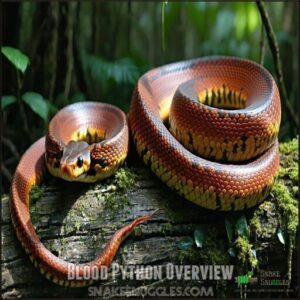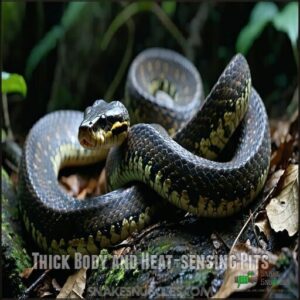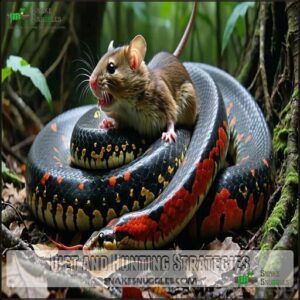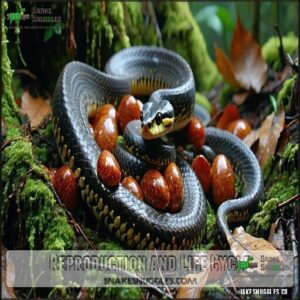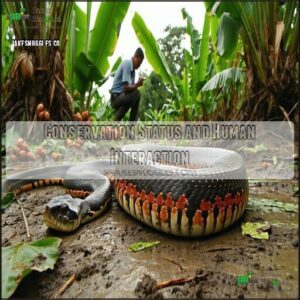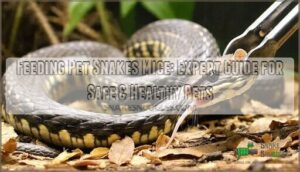This site is supported by our readers. We may earn a commission, at no cost to you, if you purchase through links.
 You’ll find that blood pythons aren’t the temperamental creatures many believe them to be.
You’ll find that blood pythons aren’t the temperamental creatures many believe them to be.
Native to Southeast Asia, these stocky snakes typically grow 4-5 feet long with impressive girth and striking red to brown coloration.
They’re ambush predators with heat-sensing pits that help them detect prey in their swampy habitats.
While they’ve earned a reputation for being nippy, properly socialized blood pythons can become remarkably docile pets.
They require specific humidity levels (60-80%) and temperatures (75-85°F) to thrive in captivity.
Understanding their body language is the key to developing a trusting relationship with these misunderstood reptiles.
Table Of Contents
Key Takeaways
- You’ll need to maintain specific conditions like 60-80% humidity and 75-85°F temperatures for blood pythons to thrive.
- With proper handling and socialization, blood pythons can transition from defensive to calm and manageable pets.
- They’re powerful ambush predators with heat-sensing pits and dense muscles, making them excellent constrictors.
- Blood pythons can live up to 25 years, requiring consistent care, a proper habitat, and patience to ensure a rewarding experience.
Blood Python Overview
The magnificent Blood Python (Python brongersmai) commands attention with its robust presence in the reptile world.
Native to Southeast Asia’s humid swamps, these shorttailed pythons have evolved from wild specimens to enchanting pets.
Their taxonomy places them among non-venomous constrictors, despite common misconceptions about their temperament.
While wild blood pythons can be defensive, captive morphs bred in controlled environments often display calmer dispositions.
Wild blood pythons may strike defensively, but captive-bred morphs often reveal surprisingly gentle temperaments with proper handling.
Their distinctive red coloration develops around age two, making them sought-after by enthusiasts.
For the beginner snake keeper considering a cost analysis, python brongersmai represents a significant investment—both financially and in care requirements.
With proper handling, these snakes can live up to 25 years, offering decades of fascination for those drawn to their unique characteristics.
Physical Characteristics and Behavior
You’ll notice blood pythons develop their signature red coloration by age three and possess distinctive heat-sensing pits that help them detect prey in dark environments.
These non-venomous constrictors have thick, muscular bodies perfect for squeezing prey, growing up to 5-6 feet long for females and 3-5 feet for males with a substantial weight that can exceed 20 pounds, making them a notable species due to their muscular bodies.
Thick Body and Heat-sensing Pits
Blood pythons feature four distinctive physical characteristics that define their predatory nature:
Blood pythons wield four evolutionary weapons that transform these muscular ambush masters into perfect predators.
- Muscular Anatomy: Their exceptionally thick body isn’t fat but dense muscle designed specifically for powerful constriction.
- Sensory Perception: Heat-seeking pits along their lips detect infrared radiation, creating thermal images of prey in complete darkness.
- Adaptive Coloration: Their scales blend from blood red to brown, providing natural camouflage in forest floor environments.
- Temperature Regulation: Unlike mammals, these snakes rely on external heat sources, adjusting their body positioning to maintain ideal temperature.
The python’s stocky build serves as its power center, like a weightlifter’s frame built for strength rather than speed.
These pits contain TRPA1 ion channels that amplify temperature changes.
Diet and Hunting Strategies
While their muscular bodies and heat-sensing pits make blood pythons formidable hunters, their prey selection and hunting strategies are equally impressive. These snakes are consummate ambush predators, patiently waiting for the perfect moment to strike rather than chasing their meals.
In the wild, python diet consists primarily of rodents and small mammals, with occasional birds when available. Using their constriction technique, they immobilize prey before consumption.
| Feeding Aspect | Captive Care | Wild Behavior |
|---|---|---|
| Prey Type | Frozen/thawed rodents | Live mammals, birds |
| Frequency | Adults: 10-14 days |
Juveniles: weekly
You’ll want to mirror these natural feeding patterns in captivity. Many owners buy pre-killed rodents online for convenience. Offer appropriately sized frozen/thawed rodents using feeding tongs to prevent accidental bites. Adult pythons typically eat every 10-14 days, while juveniles require weekly meals.
Habitat and Range
You’ll find blood pythons primarily in the marshy areas, swamps, and humid forests of Southeast Asia, including Thailand, Sumatra, and the Malay Peninsula.
These snakes prefer low-lying wetlands and can also be found near agricultural lands and water sources up to 2,130 feet above sea level, which is a notable elevation.
Preferred Environments
Throughout the dense wetlands of Southeast Asia, blood pythons have adapted perfectly to life in specific environments.
Their preferred habitats include:
- Marshy lowlands with thick vegetation providing essential cover from predators
- Humid tropical swamps where consistent moisture levels support their skin health
- Forest floors layered with leaf litter offering natural insulation and prey opportunities
- Areas adjacent to water bodies maintaining ideal humidity levels (60-70%)
- Low-elevation regions with stable temperature conditions year-round
In captivity, your blood python’s enclosure should mirror these natural conditions.
Provide appropriate enclosure size with more horizontal space than vertical height.
Maintain a temperature gradient between 80-88°F using reliable heating elements.
Reptile keepers often source specialized heat sources for consistent temperatures.
Select moisture-retaining substrate choices like cypress mulch or coconut husk.
Multiple hiding spots are essential, as these snakes prefer security over climbing opportunities.
Unlike arboreal species, blood pythons thrive in ground-level habitats with proper humidity and temperature management.
Geographic Distribution
You’ll find blood pythons sprawling across Southeast Asia, primarily inhabiting Indonesia, Malaysia, the Malay Peninsula, and Thailand.
These adaptable reptiles thrive in various ecological zones, from Sumatra’s swamplands to Borneo’s lowland forests.
Island populations have developed unique characteristics in places like Bangka and the Lingga archipelago.
They’re typically found from sea level up to 650 meters in elevation limits.
Climate influence shapes their distribution patterns, with most preferring tropical humidity.
Despite habitat fragmentation concerns, they’ve shown remarkable range expansion in human-modified landscapes, particularly oil palm plantations where rodent prey abounds.
Python snake distribution includes varied habitats, from rocky outcrops to dense forests, demonstrating their ability to thrive in human-modified landscapes and varied habitats.
Reproduction and Life Cycle
You’ll discover that blood pythons reproduce through a fascinating process where females lay clutches of 4-12 eggs after a gestation period of about 2-3 months.
The eggs then require approximately 60 days of incubation before hatchlings emerge, already displaying their distinctive coloration patterns though lacking the vibrant red hues that will develop as they mature.
Breeding Season and Egg Details
During mating rituals, blood pythons typically breed between November and February when temperatures naturally drop.
These oviparous snakes exhibit fascinating python breeding behaviors in both wild and captive breeding environments.
After successful mating, females produce impressive clutches:
- Clutch Size: Females lay 12-30 large, leathery eggs per breeding cycle
- Egg Incubation: Mother snakes coil protectively around eggs, maintaining ideal 88-90°F temperatures
- Genetic Variations: Different bloodlines produce varying color morphs and patterns
- Maternal Investment: Females rarely feed during the 60-day incubation period, dedicating all energy to egg care.
Proper incubation requires maintaining stable temperatures for successful hatching.
Incubation Period and Hatchlings
Moving from breeding behaviors to the next essential phase, proper incubation determines your success with blood python breeding.
When incubating blood python eggs, maintain temperatures at 88-90°F with 90-100% humidity for ideal egg development. The incubation period typically lasts 70-90 days, resulting in 10-20 hatchlings per clutch.
You can find a suitable incubator online for maintaining these conditions.
| Factor | Details |
|---|---|
| Temperature | 28-32°C (ideal) |
| Humidity | 90-100% |
| Duration | 45-60 days |
| Success Rate | 80-95% with proper care |
Hatchlings emerge measuring 12-18 inches long, immediately equipped with heat-sensing pits and hunting instincts. They’re independent from birth and grow rapidly, reaching sexual maturity within 2-3 years.
For their first meal, offer appropriately-sized prey items like pinky mice one week after hatching. Monitor growth rate carefully—healthy hatchlings should steadily gain weight without common issues like regurgitation or dehydration.
Oviparous by nature, captive breeding success depends entirely on your attention to these details.
Conservation Status and Human Interaction
Maintaining a "Least Concern" status on the IUCN Red List, blood pythons demonstrate remarkable resilience despite human impacts.
While habitat loss affects many reptiles, these adaptable snakes often thrive in palm oil plantations where rodent prey is abundant.
Human interaction with blood pythons occurs through several channels:
- The leather trade harvests approximately 10,000 wild specimens annually
- The pet trade prefers captive-bred individuals, reducing pressure on wild populations
- Conservation efforts focus on sustainable harvesting practices and habitat protection
- Modified environments sometimes benefit these snakes by increasing prey availability
Despite challenges, blood python conservation shows promise. Their adaptability to human-altered landscapes provides a buffer against extinction, though ongoing monitoring remains necessary to guarantee their continued survival in the wild.
Frequently Asked Questions (FAQs)
How aggressive are blood pythons?
Like a ticking time bomb, blood pythons often get an unfair reputation.
You’ll find they’re generally calm when properly cared for, but can become defensive and bite if they feel threatened or uncomfortable.
Are blood pythons good pets?
Blood pythons can be rewarding pets for experienced reptile keepers.
They’re not for beginners due to their potential aggression and specific care requirements.
With proper handling and housing, they’ll thrive in your care.
How big can blood pythons get?
While they’re often underestimated, blood pythons can grow quite large.
Your pet could reach 5-6 feet in length for females and 3-5 feet for males, with some exceptional specimens reaching up to 8 feet.
Are blood pythons hard to care for?
You’ll find these snakes demanding moderate care.
They’re not beginner-friendly due to their specific temperature and humidity needs, plus they can be temperamental.
With proper setup and handling, you’ll manage their care successfully.
What are blood pythons?
Python brongersmai are mid-sized, non-venomous snakes known for their distinctive blood-red coloration. You’ll find these muscular constrictors in Southeast Asian swamps and forests, where they can live up to 25 years.
Can you handle blood pythons?
Yes, you can handle blood pythons, but they’re not for beginners.
With patience and respect, you’ll develop trust.
Support their body weight completely during handling and wait at least a month before handling new arrivals.
What is a blood python?
A blood python is a thick-bodied, non-venomous snake named for its striking red coloration.
It’s a powerful constrictor, prefers marshy habitats, and can live up to 25 years.
How big do Blood pythons get?
These snakes usually grow 3-5 feet for males, while females reach 4-6 feet, occasionally hitting 8 feet.
With a thick, muscular build, they’re short but hefty, weighing up to 20 pounds or more.
Are blood pythons venomous?
Don’t let their striking looks fool you—these reptiles are non-venomous.
Blood pythons rely on muscle power, not venom, to subdue prey.
Their constriction method makes them effective hunters, not dangerous venom carriers.
Why are Blood pythons so popular?
You’re drawn to their striking red hues, manageable size, and unique personalities.
Their muscular build symbolizes strength, while their calm demeanor (when handled properly) makes them an irresistible choice for experienced keepers craving an exotic pet with a unique personality.
Conclusion
Few creatures are as fascinating as the blood python. With their striking colors, heat-sensing pits, and ambush hunting techniques, these snakes are true marvels of evolution.
If you’re ready to meet their care needs—proper humidity, temperature, and socialization—you can enjoy a calm and rewarding relationship with one.
Native to Southeast Asia’s wetlands, blood pythons thrive when their natural behaviors are respected. Learn their cues, provide the right environment, and you’ll gain a unique reptilian companion.

